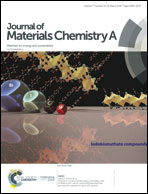Dihydropyreno[1,2-b:6,7-b′]dithiophene based electron acceptors for high efficiency as-cast organic solar cells†
Abstract
Two novel fused ring electron acceptors PDT and PDT-T have been designed, synthesized and used in organic solar cells. PDT comprises a central 4,10-bis(hexyloxy)-6,6,12,12-tetrakis(4-hexylphenyl)-6,12-dihydropyreno[1,2-b:6,7-b′]dithiophene (DDT) donor unit and two flanked 2-(5,6-difluoro-3-oxo-2,3-dihydro-1H-inden-1-ylidene)malononitrile acceptor units, while PDT-T has an extra thiophene bridge unit between the central donor unit and the acceptor unit. The introduction of a thiophene bridge unit can markedly broaden the absorption of acceptors and enhance the film absorption coefficient. The optical bandgaps of PDT and PDT-T are 1.59 and 1.44 eV, respectively. The photovoltaic performance of these two acceptors was investigated using PBDB-T as the electron donor. Wide photo-current responses extending to 800 nm for PDT based devices and to 900 nm for PDT-T based ones were observed. A power conversion efficiency (PCE) of 7.07% for PBDB-T:PDT based cells was obtained with a Voc of 0.96 V, Jsc of 13.48 mA cm−2 and FF of 54.0%, while the as-cast devices based on PBDB-T:PDT-T gave rise to a PCE of 11.02% with a Voc of 0.88 V, Jsc of 18.88 mA cm−2 and FF of 66.3%. These results highlight that DDT is a promising building block for constructing highly efficient fused ring acceptors and π-bridging can further boost the photovoltaic performance of the devices.
![Graphical abstract: Dihydropyreno[1,2-b:6,7-b′]dithiophene based electron acceptors for high efficiency as-cast organic solar cells](/en/Image/Get?imageInfo.ImageType=GA&imageInfo.ImageIdentifier.ManuscriptID=C9TA00614A&imageInfo.ImageIdentifier.Year=2019)
- This article is part of the themed collection: 2019 Journal of Materials Chemistry A HOT Papers


 Please wait while we load your content...
Please wait while we load your content...